Cleansing of the Temple
The cleansing of the Temple narrative tells of Jesus expelling the merchants and the money changers from the Temple, and occurs in all four canonical gospels of the New Testament. The scene is a common motif in Christian art.
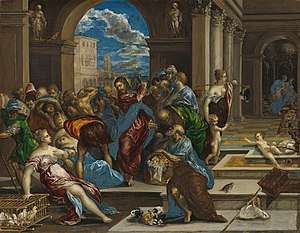
| Events in the |
| Life of Jesus according to the canonical gospels |
|---|
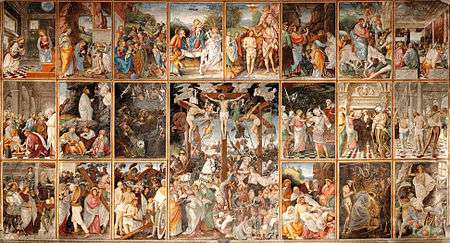 |
|
In rest of the NT |
|
Portals: |
In this account, Jesus and his disciples travel to Jerusalem for Passover, where Jesus expels the merchants and consumers from the Temple, accusing them of turning the Temple into "a den of thieves" through their commercial activities. Do not mistake Jesus's use of the term "thieves" as literal thieves, but rather robbers of the people's time with God. This sentiment is further supported by Jesus's curing of the "blind and the lame" referring to their inability to see God and the resulting weakness due to this fact.[1][2]
The narrative occurs near the end of the Synoptic Gospels (at Matthew 21:12–17, Mark 11:15–19, and Luke 19:45–48) and near the start in the Gospel of John (at John 2:13–16). Some scholars believe that these refer to two separate incidents, given that the Gospel of John also includes more than one Passover.[3]
Description
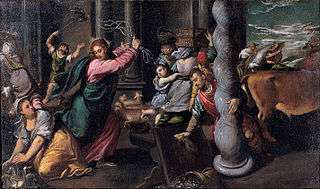
Jesus is stated to have visited the Temple in Jerusalem, where the courtyard is described as being filled with livestock, merchants, and the tables of the money changers, who changed the standard Greek and Roman money for Jewish and Tyrian shekels.[1] Jerusalem was packed with Jews who had come for Passover, perhaps numbering 300,000 to 400,000 pilgrims.[4][5]
And making a whip of cords, he drove them all out of the temple, with the sheep and oxen. And he poured out the coins of the money-changers and overturned their tables. And he told those who sold the pigeons, "Take these things away; do not make my Father's house a house of trade".
And Jesus went into the temple of God, and cast out all them that sold and bought in the temple, and overthrew the tables of the money changers, and the seats of them that sold doves, And said unto them, It is written, My house shall be called the house of prayer; but ye have made it a den of thieves.
In Mark 12:40 and Luke 20:47 Jesus accused the Temple authorities of thieving and this time he names poor widows as their victims, going on to provide evidence of this in Mark 12:42 and Luke 21:2. Dove sellers were selling doves that were sacrificed by the poor who could not afford grander sacrifices and specifically by women. According to Mark 11:16, Jesus then put an embargo on people carrying any merchandise through the Temple, a sanction which would have disrupted all commerce.[3][6] This occurred in the outermost court of the gentiles.
Matthew 21:14–16 says the Temple leaders questioned Jesus if he was aware the children were shouting "Hosanna to the Son of David." Jesus responded by saying "from the lips of children and infants you have ordained praise." This phrase incorporates a phrase from the Psalm 8:2, "from the lips of children and infants," believed by followers to be an admission of divinity by Jesus.[3][6]
Chronology
There are debates about when the cleansing of the Temple occurred and whether there were two separate events. St. Thomas Aquinas and St. Augustine agree that Jesus performed a similar act twice, with the less severe denunciations of the Johannine account (merchants, sellers) occurring early in Jesus's public ministry and the more severe denunciations of the synoptic accounts (thieves, robbers) occurring just before, and indeed expediting, the events of the crucifixion.
Claims about the Temple cleaning episode in the Gospel of John can be combined with non-biblical historical sources to obtain an estimate of when it occurred. John 2:13 states that Jesus went to the Temple in Jerusalem around the start of his ministry and John 2:20 states that Jesus was told: "Forty and six years was this temple in building, and you want to raise it up in three days?"[7][8]
In the Antiquities of the Jews, first-century historian Flavius Josephus wrote that (Ant 15.380) the temple reconstruction was started by Herod the Great in the 18th year of his reign 22 BC, two years before Augustus arrived in Syria in 20 BC to return the son of Phraates IV and receive in return the spoils and standards of three Roman legions (Ant 15.354).[8][9][10][11] Temple expansion and reconstruction was ongoing, and it was in constant reconstruction until it was destroyed in 70 AD by the Romans.[12] Given that it had taken 46 years of construction to that point, the Temple visit in the Gospel of John has been estimated at any time between 24–29 AD. It is possible that the complex was only a few years completed when the future Emperor Titus destroyed the Temple in 70 AD.[7][8][13][14][15]
Analysis
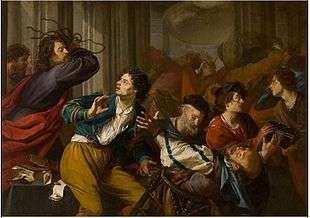
Professor David Landry of the University of St. Thomas suggests that "the importance of the episode is signaled by the fact that within a week of this incident, Jesus is dead. Matthew, Mark, and Luke agree that this is the event that functioned as the 'trigger' for Jesus' death."[16]
Given the fact that the actions of Jesus prompted no intervention on the part of either the Temple guards, nor the legionaries in the Antonia, Pope Francis sees the Cleansing of the Temple not as a violent act but more of a prophetic demonstration.[17] In addition to writing and speaking messages from God, Israelite or Jewish nevi'im ("spokespersons", "prophets") often acted out prophetic parables in their life.[18]
Butler University professor James F. McGrath explains that the animal sales were related to selling animals for use in the animal sacrifices in the Temple. He also explains that the moneychangers in the temple existed to convert the many currencies in use into the accepted currency for paying the Temple taxes.[19] E. P. Sanders and Bart Ehrman say that Greek and Roman currency was converted to Jewish and Tyrian money.[1][2]
A common interpretation is that Jesus was reacting to the practice of money changers routinely cheating the people, but Marvin L. Krier Mich observes that a good deal of money was stored at the temple, where it could be loaned by the wealthy to the poor who were in danger of losing their land to debt. The Temple establishment therefore co-operated with the aristocracy in the exploitation of the poor. One of the first acts of the First Jewish-Roman War was the burning of the debt records in the archives.[20]
According to later sources
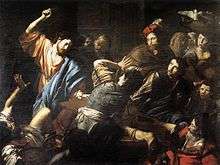
Toledot Yeshu
There are a number of later embellishments to the narrative of the incident that are generally regarded as legendary or polemical by scholars. The Toledot Yeshu, a parody gospel probably first written down about 1,000 years later but possibly dependent on second-century Jewish-Christian gospel[21] if not oral traditions that might go back all the way to the formation of the canonical narratives themselves,[22] claims that Yeshu had entered the Temple with 310 of his followers. That Christ's followers had indeed entered the Temple, and in fact the Holy of Holies,[23] is also claimed by Epiphanius, who claims that James wore the breastplate of the high priest and the high priestly diadem on his head and actually entered the Holy of Holies,[24] and that John the Beloved had become a sacrificing priest who wore the mitre,[25] which was the headdress of the high priest.
Yeshu was likewise accused of robbing the shem hamphorash, the 'secret name of god' from the Holy of Holies, in the Toledot Yeshu.[26]
Narrative of Joseph of Arimathea
According to the apocryphal Narrative of Joseph of Arimathea, Demas, one of the two robbers who were crucified with Christ,[27] stole the 'secret deposit' of Solomon from the Holy of Holies, an act which Judas blamed on Christ:
He [Demas] made attacks upon the rich, but was good to the poor…And he set his hand to robbing the multitude of the Jews, and stole the law itself in Jerusalem, … And to Caiaphas and the multitude of the Jews it was not a Passover, but it was a great mourning to them, on account of the plundering of the sanctuary by the robber … Judas says to the Jews: Come, let us hold a council; for perhaps it was not the robber that stole the law, but Jesus himself, and I accuse him.[28]
In art
The cleansing of the Temple is a commonly depicted event in the Life of Christ, under various titles.
El Greco painted several versions:
- Christ Driving the Money Changers from the Temple (El Greco, London)
- Christ Driving the Money Changers from the Temple (El Greco, Madrid)
- Christ Driving the Money Changers from the Temple (El Greco, Minneapolis)
- Christ Driving the Money Changers from the Temple (El Greco, New York)
- Christ Driving the Money Changers from the Temple (El Greco, Washington)
Gallery
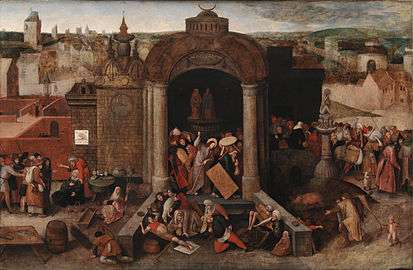 Cleansing of the Temple. Unknown artist
Cleansing of the Temple. Unknown artist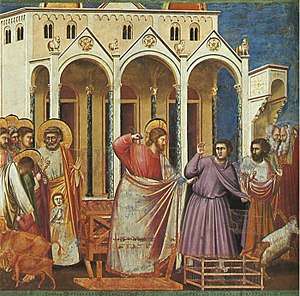 Casting out the money changers by Giotto
Casting out the money changers by Giotto- Christ driving the money changers from the temple by Jan Sanders van Hemessen
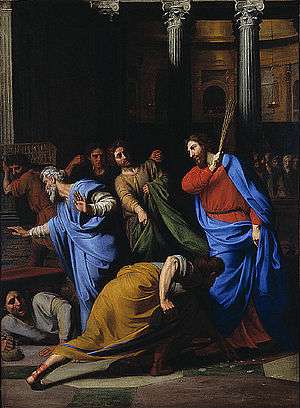 Christ Expelling the Money-Changers from the Temple by Nicolas Colombel
Christ Expelling the Money-Changers from the Temple by Nicolas Colombel_-_Christ_Cleansing_the_Temple_-_Google_Art_Project.jpg) Christ Cleansing the Temple by Bernardino Mei
Christ Cleansing the Temple by Bernardino Mei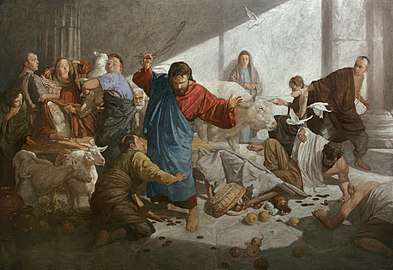 Expulsion of the merchants from the temple by Andrei Mironov
Expulsion of the merchants from the temple by Andrei Mironov
References
- Brown, Raymond E. An Introduction to the New Testament, Doubleday (1997) ISBN 0-385-24767-2
- Brown, Raymond E. The New Jerome Biblical Commentary, Prentice Hall (1990) ISBN 0-13-614934-0
- Ched Myers, Binding the Strong Man: A political reading of Mark's story of Jesus, Orbis (1988) ISBN 0-88344-620-0
- Miller, Robert J. The Complete Gospels, Polebridge Press (1994), ISBN 0-06-065587-9
Notes
- Sanders, E. P. The Historical Figure of Jesus. Penguin, 1993.
- Ehrman, Bart D.. Jesus, Interrupted: Revealing the Hidden Contradictions in the Bible (And Why We Don't Know About Them), HarperCollins, 2009. ISBN 0-06-117393-2
- The Bible Knowledge Background Commentary by Craig A. Evans 2005 ISBN 0-7814-4228-1 page 49
- Sanders, E. P. The Historical Figure of Jesus. Penguin, 1993. p. 249
- Funk, Robert W. and the Jesus Seminar. The Acts of Jesus: The Search for the Authentic Deeds of Jesus. HarperSanFrancisco. 1998.
- The Fourth Gospel And the Quest for Jesus by Paul N. Anderson 2006 ISBN 0-567-04394-0 page 158
- Paul L. Maier "The Date of the Nativity and Chronology of Jesus" in Chronos, Kairos, Christos: Nativity and Chronological Studies by Jerry Vardaman, Edwin M. Yamauchi 1989 ISBN 0-931464-50-1 pages 113–129
- Eerdmans Dictionary of the Bible 2000 Amsterdam University Press ISBN 90-5356-503-5 page 249
- The Cradle, the Cross, and the Crown: An Introduction to the New Testament by Andreas J. Köstenberger, L. Scott Kellum 2009 ISBN 978-0-8054-4365-3 pages 140–141
- Encyclopedia of the Historical Jesus by Craig A. Evans 2008 ISBN 0-415-97569-7 page 115
- As stated by Köstenberger & Kellum (page 114) there is some uncertainty about how Josephus referred to and computed dates, hence various scholars arrive at slightly different dates for the exact date of the start of the Temple construction, varying by a few years in their final estimation of the date of the Temple visit.
- Eerdmans Dictionary of the Bible, page 246 states that Temple construction never completed, and that the Temple was in constant reconstruction until it was destroyed in 70 AD/CE by the Romans, and states that the 46 years should refers to the actual number of year from the start of the construction.
- The Riddles of the Fourth Gospel: An Introduction to John by Paul N. Anderson 2011 ISBN 0-8006-0427-X page 200
- Herod the Great by Jerry Knoblet 2005 ISBN 0-7618-3087-1 page 184
- Jesus in Johannine Tradition by Robert Tomson Fortna, Tom Thatcher 2001 ISBN 978-0-664-22219-2 page 77
- "Landry, David. "God in the Details: The Cleansing of the Temple in Four Jesus Films", Journal of Religion and Film, Vol. 13, No. 2 October 2009, University of Nebraska at Omaha". Archived from the original on 6 October 2016. Retrieved 26 September 2016.
- Pope Francis. "Angelus Address: Jesus Cleanses the Temple of Jerusalem". Zenit, March 4, 2018. Translated from the Italian by Virginia M. Forrester.
- Lockyer, Herbert. All the Parables of the Bible, Zondervan, 1988. ISBN 9780310281115
- McGrath, J., Jesus and the Money Changers (John 2:13-16), accessed 6 April 2020
- Mich, Marvin L. Krier. The Challenge and Spirituality of Catholic Social Teaching, Chapter 6, Orbis Books, 2011, ISBN 9781570759451
- Price, Robert (2003) The Incredible Shrinking Son of Man, p. 40.
- Alexander, P. 'Jesus and his Mother in the Jewish Anti-Gospel (the Toledot Yeshu)', in eds. C. Clivaz et al., Infancy Gospels, Tübingen: Mohr Siebeck GmbH & Co. KG, 2011, pp. 588-616.
- Goldstein, Morris. Jesus in the Jewish Tradition. New York, NY: The Macmillan Company, 1950, p. 152.
- Bauckham, The Testimony of the Beloved Disciple, p. 45.
- Eisenman, Robert, Maccabees, Zadokites, Christians, and Qumran: A New Hypothesis of Qumran Origins. Nashville, TN: Grave Distractions Publications, 2013, p. 10.
- Zindler, Frank R. The Jesus the Jews Never Knew. Cranford, NJ: American Atheist Press, 2003, pp. 318–319, 428–431.
- Matthew 27:38.
- Narrative of Joseph of Arimathæa, 1. in The Catholic Encyclopedia
External links
Cleansing of the Temple | ||
| Preceded by Wedding in Cana in John 2 or Triumphal Entry in the Synoptic Gospels |
New Testament
Events |
Succeeded by Jesus & Nicodemus in John 3 or Fig Tree Cursed in the Synoptic Gospels |